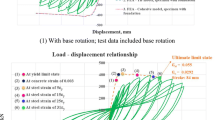Abstract
For a better understanding of the strains and stresses, numerical simulation was conducted by using ANSYS under the assumption of absolute bond between the steel and concrete. The results show that the stresses and strains in such concrete and steel rings are uneven; the curves of strains and stresses change gradually around the interface. To ease numerical computation, the mechanical system was simplified under the assumptions of synchronous deformation and uniform strains and stresses. The results of the numerical simulation and simplified stress calculation can match almost perfectly. It means that the simplified mechanical model can be used in stress and visco-elastic behavior quantification.
Similar content being viewed by others
References
Hossain A B, Weiss J. Assessing Residual Stress Development and Stress Relaxation in Restrained Concrete Ring Specimens[J]. Cement & Concrete Composite, 2004, 26:531–540
Pigeon M, Toma G, Delagrave A, et al. Equipment for the Analysis of the Behavior of Concrete under Restrained Shrinkage at Early Ages[J]. Magazine of Concrete Research, 2000, 52(4): 297–302
Kovler K. Testing System for Determining the Mechanical Behavior of Early Age Concrete under Restrained and Free Uniaxial Shrinkage[J]. Materials and Structures, 1994, 27: 324–330
AASHTO. Standard Practice for Estimating the Cracking Tendency of Concrete[S]. 2000
ASTM C1581-04. Standard Test Method for Determining Age at Cracking and Induced Tensile Stress Characteristics of Mortar and Concrete under Restrained Shrinkage[S]. 2004
Whiting D A, Detwiler R J, Lagergren E S. Cracking Tendency and Drying Shrinkage of Silica Fume Concrete for Bridge Deck Application[J]. ACI Materials Journal, 2000, 97(1): 71–76
Shah S P, Ouyang C, Marikunte S, et al. A Method to Predict Shrinkage Cracking of Concrete[J]. ACI Materials Journal, 1998, 95(4): 339–346
See H T, Attiogbe E K, Milgenberger M A. Shrinkage Cracking Characteristics of Concrete Using Ring Specimens[J]. ACI Materials Journal, 2003, 100(3): 239–245
Ma Xinwei, Cao Lixin, R D Hooton, et al. Time-dependent Early-age Behaviors of Concrete Under Restrained Condition[J]. Journal of Wuhan University of Technology, 2007, 22(2): 350–353
Author information
Authors and Affiliations
Corresponding author
Additional information
Funded by the National Natural Science Foundation of China (No.50678054)
Rights and permissions
About this article
Cite this article
Ma, X., Li, X., Wang, C. et al. Numerical simulation and assessment of self-induced tensile stresses in steel ring restrained concrete. J. Wuhan Univ. Technol.-Mat. Sci. Edit. 25, 530–533 (2010). https://doi.org/10.1007/s11595-010-0037-8
Received:
Accepted:
Published:
Issue Date:
DOI: https://doi.org/10.1007/s11595-010-0037-8




